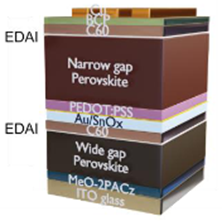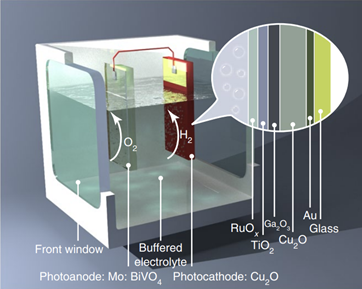Light Harvesting
The fabrication of commercially available silicon solar cells typically requires high energy demanding growth of a single crystalline ingot from a 1420°C hot melt. Hybrid perovskites, in contrast, are low-cost semiconductors with crystallisation temperatures of around 100°C. High-quality thin films can be deposited by slot-die coating, spin-coating, or thermal evaporation. With a direct band gap, a high absorption coefficient and ambipolar diffusion lengths, hybrid perovskites are ideal candidates for novel thin film photovoltaics. Low-cost, flexible photovoltaic devices with efficiencies that rival those of conventional thin-film photovoltaics are already possible.
Their tuneable band gap energy also makes perovskites highly attractive for tandem solar cells. By combining a wide band gap and a narrow band gap perovskite thermalization losses can be mitigated. Efficiencies are close to surpass the respective single junctions, and realistic estimates with over 30 % power conversion efficiency are within reach.
The light harvesting sub-group covers a range of low-cost devices which convert incident photons into other forms of energy. This includes photovoltaics, photoelectronic and photochemistry. Techniques include current-voltage measurements and sensitive external quantum efficiency measurements. New deposition approaches include thermal evaporation of halide perovskite films through multi-source depositions.

Improving solar cell performance via different passivation methods
In our research endeavours, we are dedicated to pioneering innovative methodologies aimed at passivating defect states and mitigating materials degradation within the light-absorbing layers of perovskite solar cells. We have employed a diverse array of novel chemicals in both our materials and device fabrication processes. This strategic approach is designed to enhance the operational stability and boost the power conversion efficiency of our solar cells.
Related Publications
1. Brenes, R., et al., Joule, 2017, 1, 155-167;
2. Abdi-Jalebi, M., et al., Nature, 2018, 555, 497-501;
3. Nagane, S., et al., Advanced Materials, 2021, 33, 2102462.
Multi-junction solar cells
Our work on tandem solar cells centres on using the advanced characterisation techniques our lab specialises in, and developing new techniques tailored to multi-junctions, to better understand how these devices operate. Based on this information, we are developing strategies to increase the efficiency and stability of perovskite multi-junctions.

Beyond 2-junction tandem solar cells, 3-junction or triple-junction solar cells have an even higher theoretical efficiency, dividing now the spectrum into three parts. The key here is to make sure that the currents are well matched between each of the subcells. This depends on the bandgap of the perovskite absorber material, thickness, and any light trapping methods. The fabrication of such devices becomes more complicated as the number of layers involved increases.
Related Publications
- Lang, F. et al., Joule 2020,4.5: 1054-1069;
- Tennyson, E. et al., ACS Energy Lett. 2021, 6, 6, 2293–2304;
- Chiang, Y. et al., ACS Energy Lett. 2023, 8, 6, 2728–2737;
- Fitzsimmons, M. et al., ACS Energy Lett. 2025, 10, 2, 713–725;
- Yang, T. et al., EES Sol., 2025, 1, 41-55
Evaporated perovskites
Our research focuses on the use of thermal evaporation for perovskite film deposition, which is an alternative approach to the fabrication of perovskite solar cells that enables large-area scalability and integration into flexible substrates. The solvent-free technique allows the incorporation of solvent-sensitive materials and design into the device architecture, opening up novel strategies to improve the device performance.
Related Publications
1. Chiang, Y. et al., ACS Energy Lett. 2023, 8, 6, 2728–2737;
2. Chiang, Y. et al., ACS Energy Lett. 2020, 5, 8, 2498–2504;
3. Lang, F. et al., RSC Adv., 2023, 13, 21138-21145.
Narrow gap perovskites
Our research is primarily focused on elucidating the influence of material processing techniques on the overall performance of solar devices. While the efficiency of lead (Pb)-based perovskite solar cells has surpassed 27%, the performance of narrow band gap perovskite solar cells, particularly those based on tin (Sn), remains constrained. We seek to gain insights into the intricate mechanisms of charge carrier recombination and transport within these materials while identifying the current limitations of existing material processing methods. Armed with this knowledge, we have proposed innovative strategies to overcome these limitations, such as tuning the doping level.
Related Publications
1. Galkowski, K., et al., ACS Energy Lett. 2019, 4, 3, 615–621;
2. Dey, K. et al., Advanced Materials, 2021, 33(40), 2102300;
3. Senanayak, P., Dey, K. et al., Nature Materials, 2022, 22(2), 216-224.
Photodetectors
Our research leverages the tunable band gap and capabilities of all-perovskite tandem solar cells to introduce a novel device concept, enabling multiband response from a single multijunction device. This device allows for rapid, optically controlled switching between bands, with the goal of achieving highly selective, narrowband, and sensitive photodetection. This advancement opens up numerous possibilities for applications in optical communications, including secure encryption.
Related Publications
1. Moseley, O. et al., ACS Photonics 2022, 9, 12, 3958–3966
2. Moseley, O. et al., ACS Appl. Energy Mater. 2023, 6, 20, 10233–10242.
Solar Fuels
Our work on solar fuels with oxide and carbon semiconductors uses solid-state heterojunctions and earth-abundant catalysts. The research is focused on the anisotropic electronic and photophysics of semiconductors by combining the advanced spectroscopic tools with unique thin-film materials.

Related Publications
1. Horizon EU ‘Fuel from the Sun’ Finalists with artificial leaves capable of producing a sustainable solar fuel, with Professor Erwin Reisner’s group: https://www.ceb.cam.ac.uk/news/cambridge-research-team-reaches-eu-fuel-sun-final-artificial-leaves-capable-producing
2. Pan, L. et al. Nat. Catal. 2018
3. Pan, L. et al. Nat. Commun. 2020
4. Pan, L. et, al. Nature. 2024
